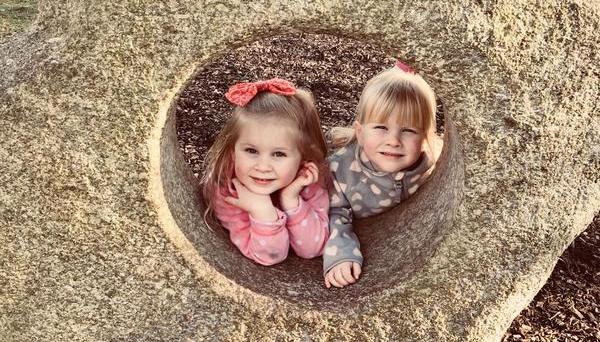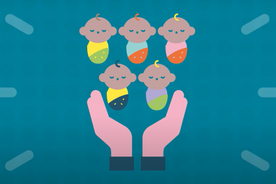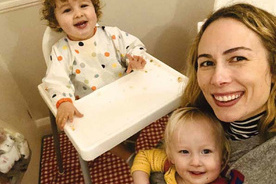What causes us to worry and how can you help your twins, triplets or more?
Written by Claire Burgess, Family Consultant, Bespoke Family.
In March 2020 I was delivering a seminar as part of the Twins Trust annual Volunteer Day. It was on the topic of anxiety in children but little did I know that when I delivered this talk that we would be heading into a pandemic and that anxiety in not only our children, but also in adults would increase dramatically over the following weeks.
Anxiety is a word that no one wants to associate with their children - we want them to be carefree, happy and certainly don’t want them to worry or have anxiety over anything. We need to be aware that anxiety can span over a significant range from mild worry which can be absolutely natural such as doing an exam or going to a new place for the first time, through to something that can be extremely worrying and can have impact on both physical and mental wellbeing.

What causes us to worry?
To keep this simple, it is all about how our brains work! Our brain has developed and adapted over time, but we still have all our ‘primal’ instincts (sometimes referred to as the monkey brain) which reacts to the emotions that we feel in different situations. This is where our fight, flight or freeze responses come from when faced with something that puts us into a state of anxiety. As we have evolved we have developed the more rational part of the brain (sometimes referred to as the human brain) and this is where, when facing a situation, we use this part of the brain to rationalise what is happening and why, along with finding a solution. When we worry about something, it is often our monkey brain which takes over and causes us to use our primal instincts rather than going with our rational/human brain. Our children need us to help them manage this and to support them in training their rational brain to kick in at times of worry or anxiety.
What might our children worry about?
Of course there is no simple answer to this question as every child is unique and worries can be very different for each of them, but some of the most common worries are:
- Social media (for lots of reasons including some of those mentioned below)
- Climate change
- Illness and death
- Friendships and peer groups
- School
- Separation from parents or main carer
- Body image
- Safety
- Separation from loved ones – please check out our blog on separation anxiety
We can sometimes feel that a child is worrying about something that in our opinion is not ‘worth worrying about’, but we need to have empathy with the child as they can’t control their worries (which is often the same for us) so, as the adult we need to be there to talk their worries through with them and be understanding as to what it might feel like.
What behaviours might you see?
Behaviours are all driven by the emotions that we are feeling at the time and the behaviour you see is the expression of what the child (or adult) is experiencing at the time.
Some of the behaviours that you might see when a child is worrying or is anxious are:
- Finding it hard to concentrate
- Not sleeping, or waking in the night with bad dreams
- Not eating properly, perhaps not having an appetite or controlling the food that they are eating. Often when we are worrying about things we feel ‘out of control’ so will find ways to gain some control and this can often be with food.
- Quickly getting angry or irritable, and being out of control during outbursts
- Constant worrying or having negative thoughts
- Feeling tense and fidgety, or using the toilet often
- Being upset
- Being clingy
- Complaining of tummy aches and feeling unwell
- Being very quiet and taking themselves off on their own.

How can you help?
No one likes to see someone who is experiencing something like worry or anxiety but everyone will experience this in some form at differing points of their lives. We want to be able to give children skills for life in how to approach or manage emotions.
Here are some practical things that you can do:
- Pay attention to your child’s feelings – when we feel that someone is really thinking about us and considering what we are going through it can really help. Using emotional language such as worried, sad, angry so that they are able to gain an understanding of what it is that they might be feeling.
- Stay calm when your child becomes anxious about a situation or event – if we really want our children to ‘be ok’ we can sometimes get worked up or anxious ourselves. The child will pick up on this which tends to escalate the situation further. Keep yourself calm and be aware that this might not be something that will change overnight and will require time and patience.
- Recognise and praise small accomplishments – positive feedback always helps and so recognising small achievements will help
- Don’t punish mistakes or lack of progress, this is not helpful and can often increase your child’s worry or anxiety, so just be there for your child as that is what they will need the most.
- Be flexible, but try to maintain a normal routine – routine does not need to be rigid but it needs to be predictable - try to keep mealtimes, nap and bedtimes as consistent as you can. This will help your child to make sense of their day.
- Modify expectations during stressful periods – if you know that your child is worrying about an exam, then try to offer them their favourite meals in the days leading up to it to help them feel relaxed and also means that they don’t need to be worrying about having to try something new that they might not enjoy or like. Keep in mind that their mood may change quickly and that this is not something that they really have control over at this time - they might not want to talk or they might want to have extra cuddles.
- Plan for transitions. For example, allow extra time in the morning if getting to school is difficult, or visit the new place that you are going to, just so that they can see it before going there for the activity.
- The worry or anxiety that you child has will not be solved by consistent exposure to it, it needs to be done gently and gradually so that they have time to adjust and to develop coping strategies. It might be that your child doesn’t like going swimming and they become very upset and worried when it is mentioned. In this case look at having more water play at home, making bathtimes fun with googles or colouring the water, then build up to reading books which have the characters going swimming or making up a story together, then just go to the local swimming pool to watch other people swim. All of this helps give exposure to the worry and the opportunity for your child to be able to see and process that it will be ok and it is not something that needs to be worried about.
- Think about your own worries and anxieties. We all have them and that is ok, but can your children pick up on these? If so then you need to be showing them the techniques that you have for managing them so that they can learn from you and understand that it is ok to have worries, but it is much better when they are shared and we have people to help us through them.
- Think about your reactions and approach to when your child tells you that they are worried about something. Try to avoid saying “you don’t need to worry about that, that’s nothing” or “it will be fine” as this is not going to help and could stop them from discussing it further. Try to look at responses such as “oh dear, I can see you are worried about that, what can I do to help?” or “Are you ok? It looks like you are worrying about something, what’s wrong?”. By asking these questions you are opening up the conversation and finding solutions together rather than shutting it down as something not to worry about.
- Very often when we are worried or anxious about something we can hold our breath or have very shallow breathing. Doing deep breathing exercises with your child can really help with calming the body and mind. There are some lovely, child appropriate techniques which involve getting your child to ‘tummy breathe’ check out sites like this one for some ideas: https://www.cosmickids.com/five-fun-breathing-practices-for-kids/
Resources which might help
The best resource is going to be you as you are able to talk to your child and be there for them during this time, but there are other things which might help depending on what the worry or anxiety might be about:
Dream catcher – if your little one is worrying at night and also having bad dreams then this might help. Introduce a dream catcher on the wall over their bed and the dreams will come in and get caught in the web. All the nice dreams will float down the feathers and into your little one’s mind and all the bad dreams stay caught in the web.
Worry dolls – your child tells the dolls the worries that they have, puts them under their pillow and the worry dolls take the worries away when they are sleeping.
Worry Monster – if your child is old enough they can write down their worries and then post them in the mouth of the worry monster. Then again over night they are taken away (the parent needs to remember to remove the worries in the night). This also gives you the opportunity for you to see what they are worried about which you might be able to help with. For younger children it might be that they tell an adult their worry, they write it down and the child posts it in the monster’s mouth.
Click here to visit Bespoke Family's page where thay have a list of books for adults and children and accounts to follow that can also help.
-strap.svg)



